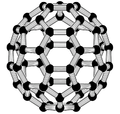
Carbon nanotube

Carbon nanotubes (CNT) are a class of nanomaterials that consist of a two-dimensional hexagonal lattice of carbon atoms, bent and joined in one direction, so as to form a hollow cylinder. Carbon nanotubes are one of the allotropes of carbon, specifically a class of fullerenes, intermediate between the buckyballs (closed shells) and graphene (flat sheets). Besides these single-wall carbon nanotubes (SWCNTs), the name is also used for multi-wall (MWCNT) variants consisting of two or more nested nanotubes, or of graphene-like strips rolled up into multiple layers like a scroll. Individual nanotubes naturally align themselves into 'ropes' held together by relatively weak van der Waals forces. While one can build nanotubes of other compositions, most of the research has been focused on carbon ones; so that the 'carbon' qualifier is often left implicit, and the names are abbreviated NT, SWNT, and MWNT. Most studies and applications of these materials have focused on tubes whose circumferences range from a few graphene cells to a few hundred cells, meaning diameters of about 0.25 to 25 nm. The common production methods are such that the length of a carbon nanotube is often indeterminate, but much larger than its diameter. Nanotubes half a meter long have been created, with a length-to-diameter ratio of more than 100,000,000:1. For many purposes, the length of carbon nanotubes can be assumed to be infinite. Thanks to their nanostructure and to the strength of the bonds between atoms, these cylindrical carbon molecules have exceptional mechanical stiffness and tensile strength. They also have moderate chemical stability, high electrical conductivity, and extraordinary thermal conductivity. These properties are expected to be valuable in many areas of technology, such as electronics, optics, composite materials (replacing or complementing carbon fibers), nanotechnology, and other applications of materials science. The properties of a long and narrow carbon nanotube (for example, whether it is a metal or semiconductor) are largely determined by its diameter and by the 'rolling' angle between the main directions of the graphene lattice and the axis of the cylinder. These parameters are constrained so that the type of nanotube can be described by two small integers. Most nanotube types are chiral, meaning that a tube cannot be rotated and translated to match its mirror image. Apart from that, carbon nanotubes are highly symmetrical: every atom in an infinite nanotube is equivalent to any other atom. The unique strength of carbon nanotubes (or fullerenes in general) is due to orbital hybridization, which causes the bonds between adjacent carbon atoms to be of the sp2 type. These bonds, which are similar to those of graphene, are stronger than the sp3 bonds in alkanes and diamond. The structure of an ideal (infinitely long) single-walled carbon nanotube is that of a regular hexagonal lattice drawn on an infinite cylindrical surface, whose vertices are the positions of the carbon atoms. Since the length of the carbon-carbon bonds is fairly fixed, there are constraints on the diameter of the cylinder and the arrangement of the atoms on it. In the study of nanotubes, one defines a 'zigzag' path on a graphene-like lattice as a path that turns 60 degrees, alternating left and right, after stepping through each bond. It is also conventional to define an 'armchair' path as one that makes two left turns of 60 degrees followed by two right turns every four steps.
